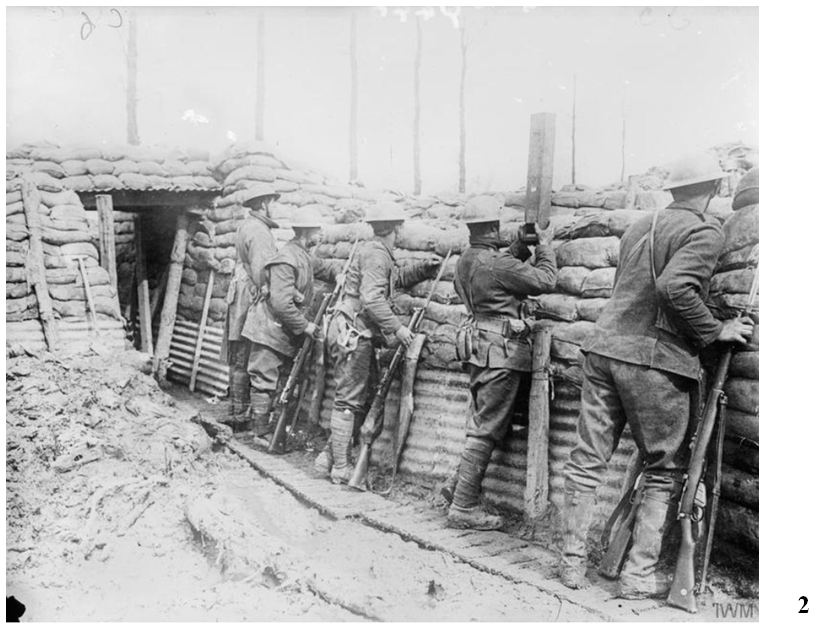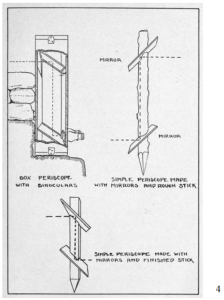Tuesday, July 27, 1915
Divisional Reserve
The Battalion War Diarist wrote nothing for this day. [1]
THIS DAY IN RMR HISTORY: “The trench periscope is an optical device that soldiers used during the First World War to observe the ground in front of their trenches and fortifications, without taking the risk of raising their eyes above the parapet and creating a target for the enemy snipers.” [3]

This photo gives an idea of trench conditions. Note the soldier second from right using a trench periscope.
Captain Leslie Vickers, of the Seaforth Highlanders of Scotland, writing in his 1917 handbook “Training for the Trenches” wrote of periscopes:
 “… the present form of trenches, being in a continuous line, makes it necessary either to construct loopholes or to look over the top of the parapet in order to fire. I have indicated, too, that there are several forms of rifles that can be fired through periscopes, but these must as yet be considered special and are not for the ordinary man to use. No doubt such a rifle will be invented and generally used in the future. But in this war we soon learned that it was “unhealthy” to put our heads above the parapet any more frequently than we had to. Therefore, in order to see what the enemy was about, and to wait for sniping opportunities we used periscopes. Some of those that were brought to France were huge cumbersome boxes that made a fine mark for the enemy’s sharpshooters. But the kind that was most generally used after the first six months of the war was that which consisted of a stick with two slanting grooves in it, one near each end, into which grooves small mirrors could be fitted. We found them quite effective, and should an accident happen and a mirror be broken they were easily replaced from the store we carried with us for that purpose. Not having a box of any kind they were very difficult to see from the enemy lines.
“… the present form of trenches, being in a continuous line, makes it necessary either to construct loopholes or to look over the top of the parapet in order to fire. I have indicated, too, that there are several forms of rifles that can be fired through periscopes, but these must as yet be considered special and are not for the ordinary man to use. No doubt such a rifle will be invented and generally used in the future. But in this war we soon learned that it was “unhealthy” to put our heads above the parapet any more frequently than we had to. Therefore, in order to see what the enemy was about, and to wait for sniping opportunities we used periscopes. Some of those that were brought to France were huge cumbersome boxes that made a fine mark for the enemy’s sharpshooters. But the kind that was most generally used after the first six months of the war was that which consisted of a stick with two slanting grooves in it, one near each end, into which grooves small mirrors could be fitted. We found them quite effective, and should an accident happen and a mirror be broken they were easily replaced from the store we carried with us for that purpose. Not having a box of any kind they were very difficult to see from the enemy lines.
Certain gunners who used to come to the trenches as Forward Observing Officers were equipped with a splendid periscope that had beautiful lenses in it. But it was very costly and could not easily be repaired if once damaged.
To make the image in the periscope clearer, binoculars can be applied to the lower glass at the proper angle, and almost as clear a view obtained as by looking over the parapet. One disadvantage of the periscope is that it makes the distance seem greater than it really is, and many a man receives a shock when he places his head above the parapet after looking through a periscope for a while, to see how close the enemy trenches are. [5]
[1] War Diary, 14th Canadian Battalion, The Royal Montreal Regiment, July 27, 1915. Library and Archives Canada, Ottawa http://data2.collectionscanada.ca/e/e044/e001089764.jpg
[2] Imperial War Museum, Ministry of Information First World War Official Collection, Cat. No. Q 446, Lieut. Ernest Brooks (Photographer), March 1916.
http://www.iwm.org.uk/collections/item/object/205077484
[3] “Trench Periscope” - Artifact Backgrounder, Canadian War Museum, Ottawa, http://ww1.canada.com/wp-content/uploads/2014/10/CWM_SupplyLine_TrenchPeriscope_EN_FINAL_20140922.pdf
[4] Captain Leslie Vickers, Late Lieut. Seaforth Highlanders, Lecturer in Trench Warfare, Department of Military Service, Columbia University, New York, “Training For The Trenches – A Practical Handbook,” George H. Doran Company, New York, 1917, pg.46; found at http://www.gutenberg.org/files/44734/44734-h/44734-h.htm
[5] Ibid, pg 87.

